
Why Trees Blow Over
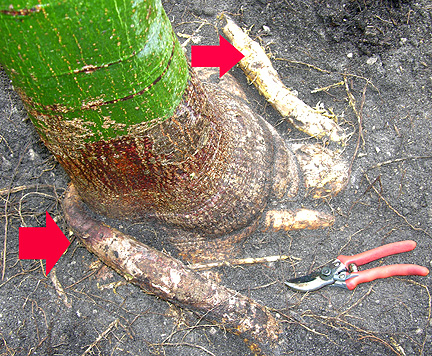
It looks like we may get through another hurricane season without a bad storm. So far we have not had to deal with any blown over trees or what is known in the arboricultural industry as windthrow. Well, this is certainly not the time to be complacent. Now is the time to review and perhaps change our bad planting and horticultural habits so we have less windthrow and the resultant damage in the next storm.
It is always interesting to hear about the reasons why trees fall down in a hurricane. I hear quite often, “It wasn’t a native tree” or perhaps, “that tree wasn’t in the right place”. Ever see a picture of someplace in the Pacific that just had a typhoon? Did you see any trees left standing? I’ll bet you did, and I would also wager that the trees left standing were not native to South Florida. In Guam I have seen some of their native plants like the palm, Heterospathe elata and the Cycad, Cycas micronesica withstand a super typhoon (Category 5 in our side of the planet). So what should you plant and how should you plant it?
First, what anchors the tree to the ground? The roots of course; the root system is what keeps the tree from blowing over. What do roots need the most? They need oxygen and water which they seek out by growing through the tiny pore spaces within and around the soil particles. When there is no more oxygen or water, the roots stop growing and often start to die.
Ever see trees planted on a newly constructed building site? The “soil” that they most likely are planted into is the structural fill that was placed onto the site and compacted before the construction began. The original fill was taken out because there was too much organic material in it and/or the rest of the soil was not homogenous in nature, meaning it will not compact well. Structural fill has consistent particle size so that it can be compacted to the point of having almost no voids between the soil particles. This compacted structural fill is critical because it will have to support the weight of the building, cars in the parking lot etc, so that there will be minimal settlement of the structures. No one wants cracked walls, saggy roof or a new parking lot full of potholes.
Well, what about the tree roots? If there is no oxygen or water because the roots can not push through the compacted fill they will stay close to the tree and hope that there is a great irrigation system and every once in a while someone will throw some fertilizer on them. Often on landscaping projects, “landscape soil” is thrown into the freshly dug hole (in the structural fill) along with the tree. That’s great! Now the roots are being encouraged to stay there.
In an act of desperation the roots usually work their way elsewhere like underneath driveways, roads, curbs and sidewalks. Why is this? These aforementioned structures are just laid upon the structural fill (for buildings and other structures a foundation is dug into the structural fill). This leaves an interface between the hard stuff (concrete and asphalt) and the structural fill below. The interface is a space that provides oxygen and moisture so that roots can grow underneath and beyond; hence bumpy roads and sidewalks next to large trees. Up north with the changes in season the expansion and contraction of concrete and asphalt is very noticeable (I recently learned of frost heaves) and favorable to root growth. In south Florida, not as dramatic but happens just as much. Roots also will follow pipes. The soil isn’t compacted around pipes or conduits and if the pipes leak water, the roots will be fat and happy and can then end up underneath your house or building. They didn’t push through that structural fill if it was properly compacted, so don’t blame the tree.
In the last few hurricanes I am sure you saw trees blown over with a flat root plate still attached and very few roots still in the ground. Parking lots were a great place to see this. The roots were never able to penetrate the surrounding soil because it was so compacted. The trees grew and maybe even had a large canopy because of irrigation systems. When the winds got strong the tiny root system could not support the movement of the canopy and the tree succumbed to windthrow. Start thinking about planting spaces a minimum of 10 feet wide with better soil.
Other horticultural practices that often are the cause of windthrow, or just tree decline and gradual death, are planting too deep and planting root bound trees. When a tree or shrub is planted either in the ground or into a container, the upper most roots that come directly out of the trunk need to be exposed, just like in nature. This is called the root flare or root collar. It will likely necessitate the removal of several inches to a foot of extra soil from the top of the root ball before planting. Why do you not want to plant too deep? It will be more difficult for oxygen to diffuse into the ground that deep and less water will percolate to that area, which will mean fewer roots to feed and hold up the tree. Also, the bark on many species of trees and shrubs will not tolerate the excessive moisture held against it by soil, or mulch, and rot will enter the tree.
Plants from nurseries seem to do well planted deeply in a container but remember they used a special soil mix with great oxygen and water holding capacity. This mix is only for the short term and will eventually decompose. Ever take a plant out of a pot only to find surface roots and roots circling around the inside of the container and none in the middle. The roots had to go where the oxygen was; on top and to the interface of the pot and soil. The rest died most likely from the lack of oxygen.
Lastly I would like to point out what happens to these circling roots that you noticed when you pulled the plant out of the pot before planting it into another pot or in the ground. Check out the photos with this article. It shows a root that does not radiate out but crosses and may even circle around the trunk. This root will never do anything to support the tree. It will eventually damage the tree and definitely make it more vulnerable to windthrow. As this root grows into the trunk, it will actually crush the xylem tissue. The xylem tissue is the vascular system that brings water and nutrients from the root system to the foliage. On larger trees with these circling roots you will often see a bulge on the trunk just above the root. This is where the sugars and food from the foliage that is passed back to the root system via the phloem system has been clogged up. My recommendation is to cut these circling roots before planting. The next time you see one side of a tree in decline, start digging. And remember, all of these issues have very little to do with the country of origin for a particular tree species.
Jeff Shimonski
November 2007



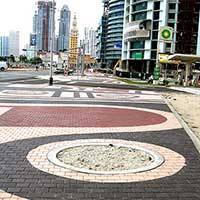

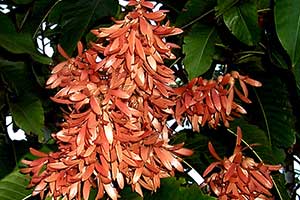 About Tropical Trees & Arboriculture
About Tropical Trees & Arboriculture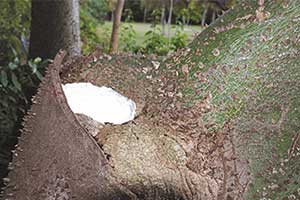 An Experiment in Arboriculture and Mosquito Control
An Experiment in Arboriculture and Mosquito Control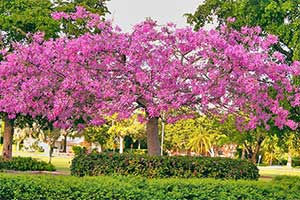 Ceiba Speciosa
Ceiba Speciosa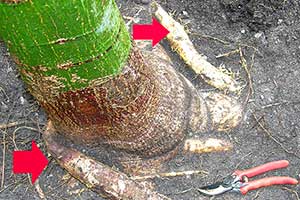 Why Trees Blow Over
Why Trees Blow Over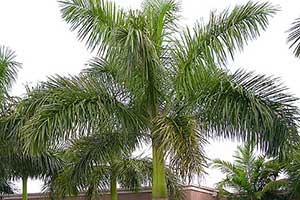 Royal Palm Bugs
Royal Palm Bugs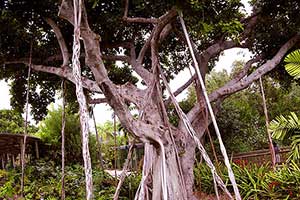 Ficus Species & Hurricane Horticulture
Ficus Species & Hurricane Horticulture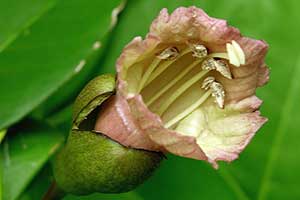 Pollination and the Natural History of the Calabash Tree
Pollination and the Natural History of the Calabash Tree Pollinating Sausage Trees
Pollinating Sausage Trees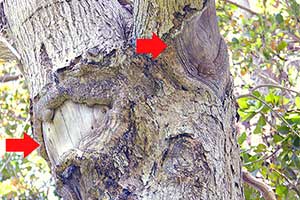 Some Observations on Relocating Tropical Trees
Some Observations on Relocating Tropical Trees